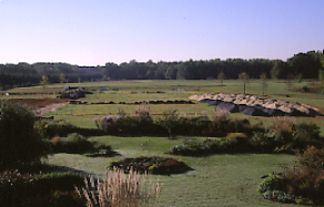|
home: www.rubythroat.org |
|
|
home: www.rubythroat.org |
|
Gardeners who want to cater to hummingbirds often seek plants with long, tubular red flowers, but hummers are attracted to all sorts of blooms. As a result, Hummingbird Habitats not only attract their intended hummingbirds, but they also can be very pleasing to the human eye.

© Bill Hilton Jr. |
Although your Hummingbird Habitat might not be as large as this one (Daniel Stowe Botanical Garden in Belmont, North Carolina USA), the properly selected flowers you plant in your yard can attract dozens of Ruby-throated Hummingbirds. |
When designing a Hummingbird Habitat, you may wish to concentrate just on native (endemic) plants that occurred historically in the breeding grounds of the Ruby-throated Hummingbird (Archilochus colubris); a selection of these is listed under "Native Plants." On the other hand, you might like to put in plants that have been imported from around the world but that have nectar-producing flowers that hummingbirds find attractive; some of these are described in the section on "Exotic Plants." If you decide to try some of the latter, be sure to select plants that are non-invasive, lest they take over an area and choke out native flora.
Many hummingbird plants will grow in full sun, or at least in locations that get some direct sunlight during the day. A few are shade-tolerant and will grow underneath a relatively dense canopy of trees. Growing Tips provided for the "Top Ten" native and exotic plants will help you choose what plants to try in your schoolyard or home landscape. Before planting, you may wish to consult horticulture books or the advice of experienced gardeners, particularly those in your own growing zone.
Please note that we choose to use the term Hummingbird Habitat rather than "Hummingbird Garden." A garden may contain just a few nectar-producing plants, while a true Hummingbird Habitat includes all types of hummingbird flowers (herbaceous plants, vines, shrubs, and trees of varied heights and bloom dates) and provides space for hummingbirds to nest and locations in which they can roost and find shelter from the elements. The well-designed Hummingbird Habitat also includes several properly maintained feeders and a water element such as a mister in which hummingbirds can bathe. The most effective Hummingbird Habitats attract and nurture tiny insects and spiders that hummingbirds use as sources for fats and proteins.
Back to Food Main
Back to Landscaping
Go to Hummingbird Feeders
Up to Top of Page
|
Make direct donations on-line through
Network for Good: |
 |
|
LIKE TO SHOP ON-LINE?
Donate a portion of your purchase price from 500+ top on-line stores via iGive: |
|
|
Use your PayPal account
to make direct donations: |
|
|
|
Share Your Hummingbird Experiences Through "Hummingbird Hobnob" |
 |
Operation |
|
|